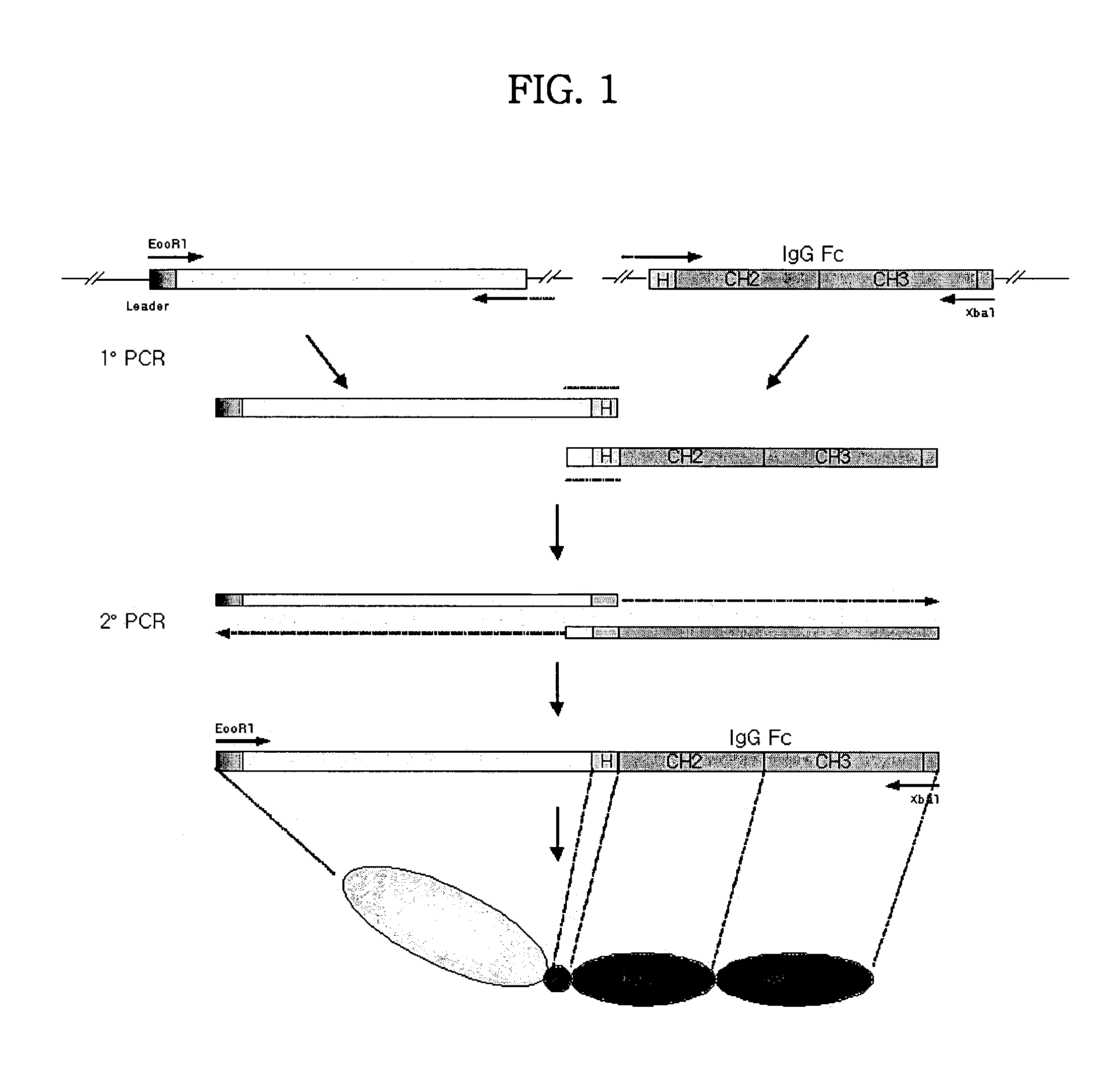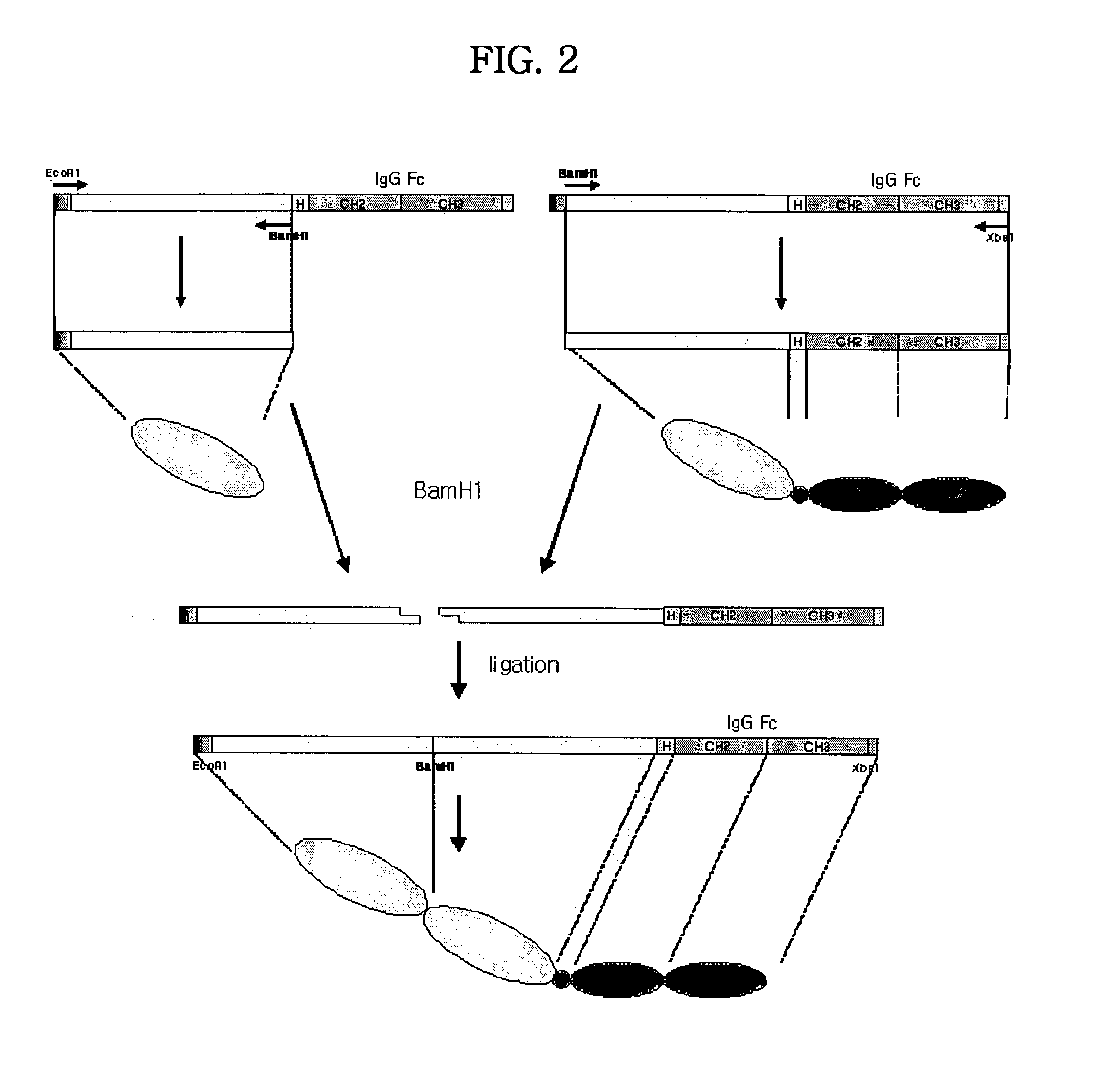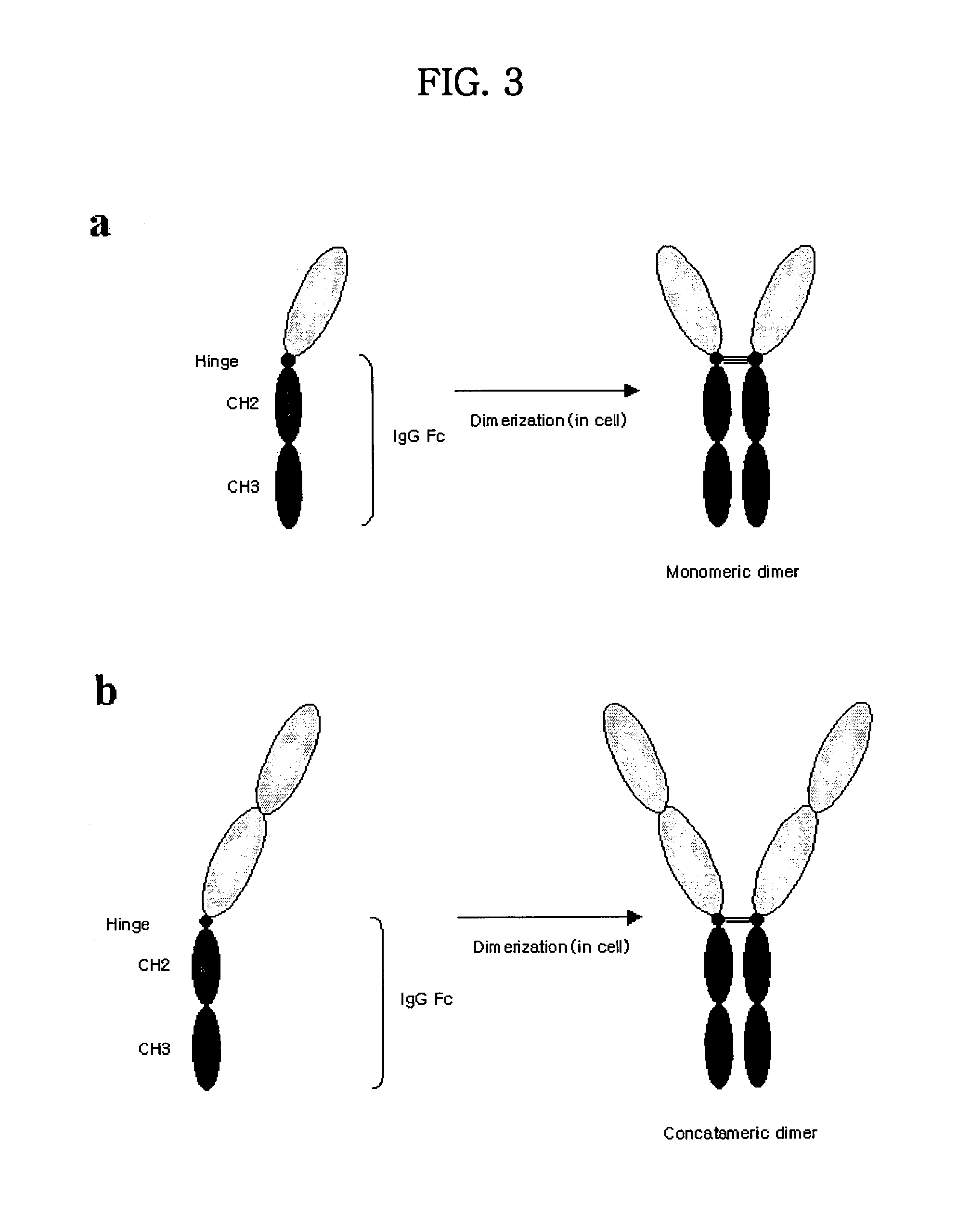Tetravalent etanercept
a technology of etanercept and tetravalent etanercept, which is applied in the field of catalytic proteins, can solve the problems of reducing the production yield of multimeric forms, unable to bind to light chains, and difficulty in purifying multimeric high molecular weight forms, etc., and achieves the effect of increasing efficacy and stability
- Summary
- Abstract
- Description
- Claims
- Application Information
AI Technical Summary
Benefits of technology
Problems solved by technology
Method used
Image
Examples
example 1
Human TNFR
A. Manufacture of a DNA Construct Encoding Simple Fusion Monomeric Protein of TNFR1 / Fc (FIG. 1 and FIG. 5)
[0115]a. DNA Fragment Encoding Soluble Extracellular Domain of TNFR1
[0116]A fusion gene encoding soluble extracellular domain of type I human TNF receptor (TNFR1, p55) and Fc fragment of human immunoglobulin G1 was constructed by the Polymerase Chain Reaction (PCR) method described in the prior art (Holten et al., Biotechniques 8:528, 1990).
[0117]A DNA fragment encoding soluble extracellular domain of TNFR1 was constructed by PCR using a primer (the sequence of nucleotide of SEQ ID NO: 25) with EcoRI restriction site and the sequence encoding leader sequence (the sequence of amino acids 1–20 of SEQ ID NO: 2), and an antisense primer (the sequence of nucleotide of SEQ ID NO: 26) with the sequence encoding a part of 3′ ends of the said soluble extracellular domain of TNFR1 (TNFR1-ED) and 5′ ends of the hinge region of immunoglobulin G1 (IgG1). The template cDNA for this ...
example 2 and 3
CD2 and CTLA4
[0156]DNA fragments encoding soluble extracellular domain of CD2 and CTLA4 were constructed by PCR using a primer [CD2(the sequence of nucleotide of SEQ ID NO: 40), and CTLA4(the sequence of nucleotide of SEQ ID NO: 43)] with EcoRI restriction site and the coding sequence [CD2 (the sequence of nucleotide of SEQ ID NO: 13), and CTLA4 (the sequence of nucleotide of SEQ ID NO: 15)] encoding the leader sequence [CD2(the sequence of amino acid 1–24 of SEQ ID NO: 14), and CTLA4(the sequence of amino acid 1–21 of SEQ ID NO: 16)], and an antisense primer [CD2(the sequence of nucleotide of SEQ ID NO: 41), and CTLA4(the sequence of nucleotide of SEQ ID NO: 44)] with PstI restriction site and the sequence [CD2(the sequence of nucleotide of SEQ ID NO: 13), and CTLA4(the sequence of nucleotide of SEQ ID NO: 15)] encoding 3′ end of the soluble extracellular domain of the proteins as described above. The template cDNA for this reaction was constructed by reverse transcription PCR (RT-...
example 4
Expression and Purification of Simple / Concatameric Fusion Dimeric Protein of TNFR / Fc
[0168]In order to express the fusion proteins in CHO-K1 cell (ATCC CCL-61, Ovary, Chinese hamster, Cricetulus griseus), after pBluescript KS II (+) plasmid DNA including TNFR / Fc fusion gene was purified from transformed E. coli, an animal cell expression vectors were constructed as TNFR / Fc fragment produced by restriction using EcoRI and XbaI was inserted at EcoRI / XbaI site of an animal cell expression vector, pCR™3 (Invitrogen, USA) plasmid. And these were designated plasmid pTR11-Top10′ and plasmid pTR22-Top10′, and deposited as accession numbers of KCCM 10288 and KCCM 10291, respectively, at Korean Culture Center of Microorganisms (KCCM) on Jul. 10. 2001.
[0169]Transfection was performed by mixing either the plasmid pTR11-Top10′ or plasmid pTR22-Top10′ DNA including TNFR / Fc fusion genes as described above with the reagent of Lipofectamin™ (Gibco BRL, USA). CHO-K1 cells with the concentration of 1˜3...
PUM
| Property | Measurement | Unit |
|---|---|---|
| temperature | aaaaa | aaaaa |
| pH | aaaaa | aaaaa |
| pH | aaaaa | aaaaa |
Abstract
Description
Claims
Application Information
 Login to View More
Login to View More - R&D
- Intellectual Property
- Life Sciences
- Materials
- Tech Scout
- Unparalleled Data Quality
- Higher Quality Content
- 60% Fewer Hallucinations
Browse by: Latest US Patents, China's latest patents, Technical Efficacy Thesaurus, Application Domain, Technology Topic, Popular Technical Reports.
© 2025 PatSnap. All rights reserved.Legal|Privacy policy|Modern Slavery Act Transparency Statement|Sitemap|About US| Contact US: help@patsnap.com



